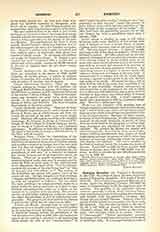

Gerald, Saint, Bishop of Mayo, an English monk, date of birth unknown; d. March 13, 731; followed St. Colman, after the Synod of Whitby (664), to Ireland, and settled at Innisboffin, in 668. Dissensions arose, after a time, between the Irish and the English monks, and St. Colman decided to found a separate monastery for the thirty English brethren. Thus arose the Abbey of Mayo (Magh Eo, the yew plain), known as “Mayo of the Saxons”, with St. Gerald as first abbot, in 670. St. Bede writes: “This monastery is to this day (731) occupied by English monks … and contains an exemplary body who are gathered there from England, and live by the labor of their own hands (after the manner of the early Fathers), under a rule and a canonical abbot, leading chaste and single lives.” Although St. Gerald was a comparatively young man, he proved a wise ruler, and governed Mayo until 697, when, it is said, he resigned in favor of St. Adamnan. Some authors hold that St. Adamnan celebrated the Roman Easter at Mayo, in 703, and then went to Skreen, in Hy Fiachrach, and that after his departure the monks prevailed on St. Gerald to resume the abbacy. The Saxon saint continued to govern the Abbey and Diocese of Mayo till his death. His feast is celebrated on March 13. Mayo, though merged in Tuam for a time, remained a separate see until 1579.
W. H. GRATTAN-FLOOD.

